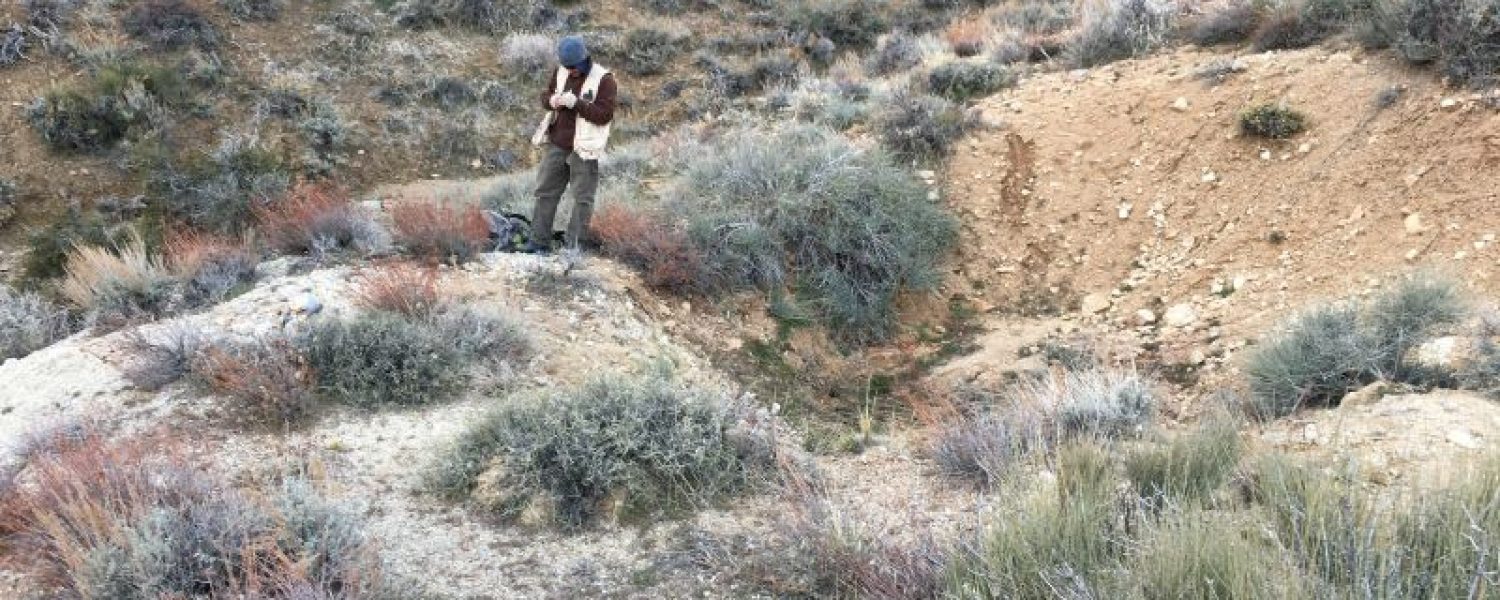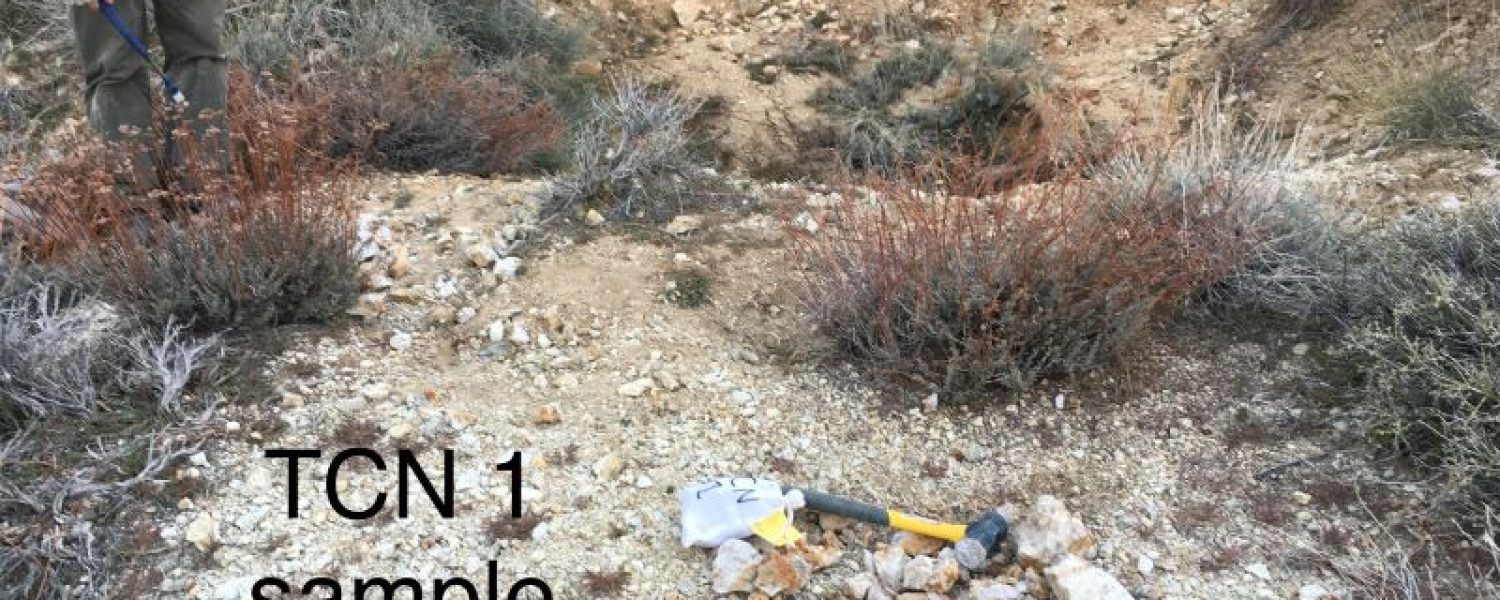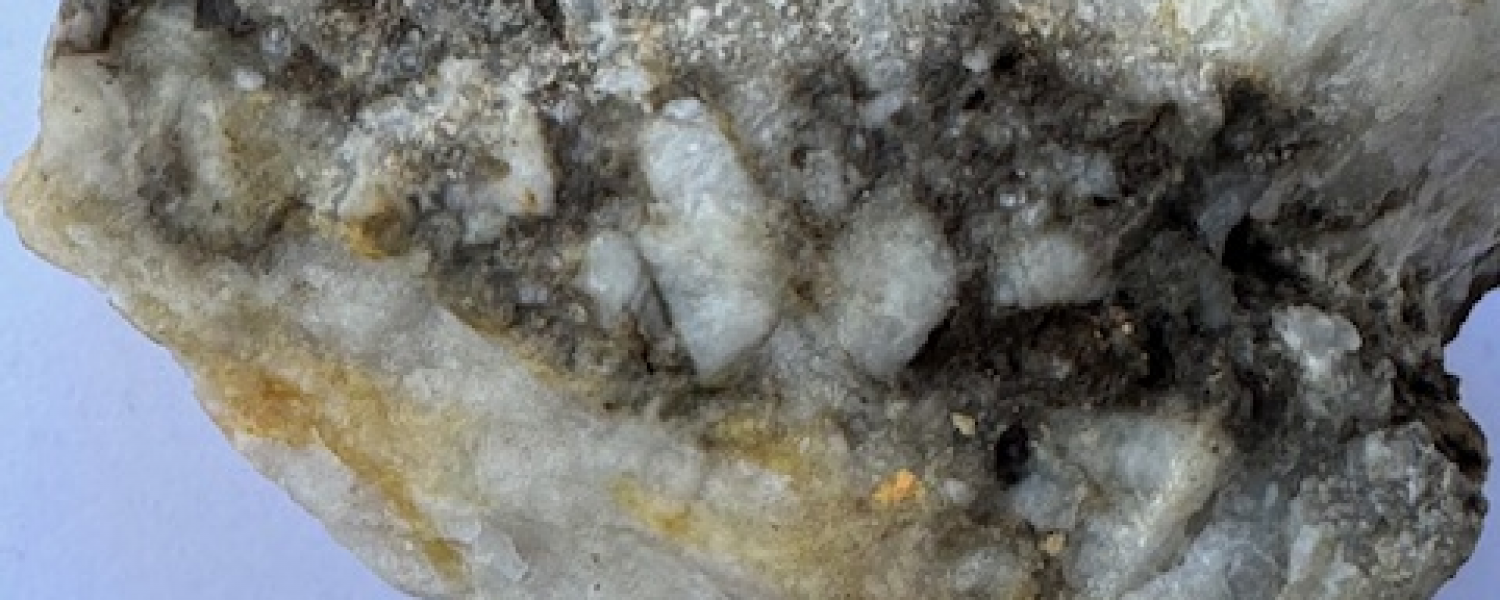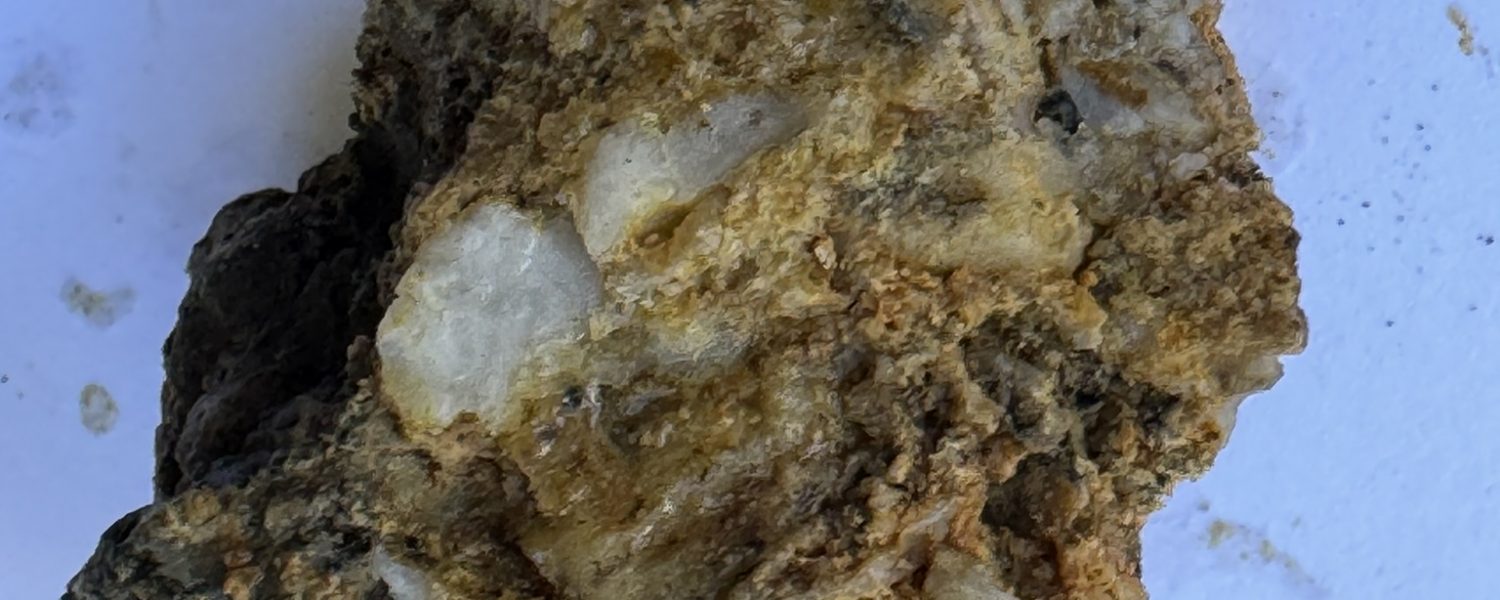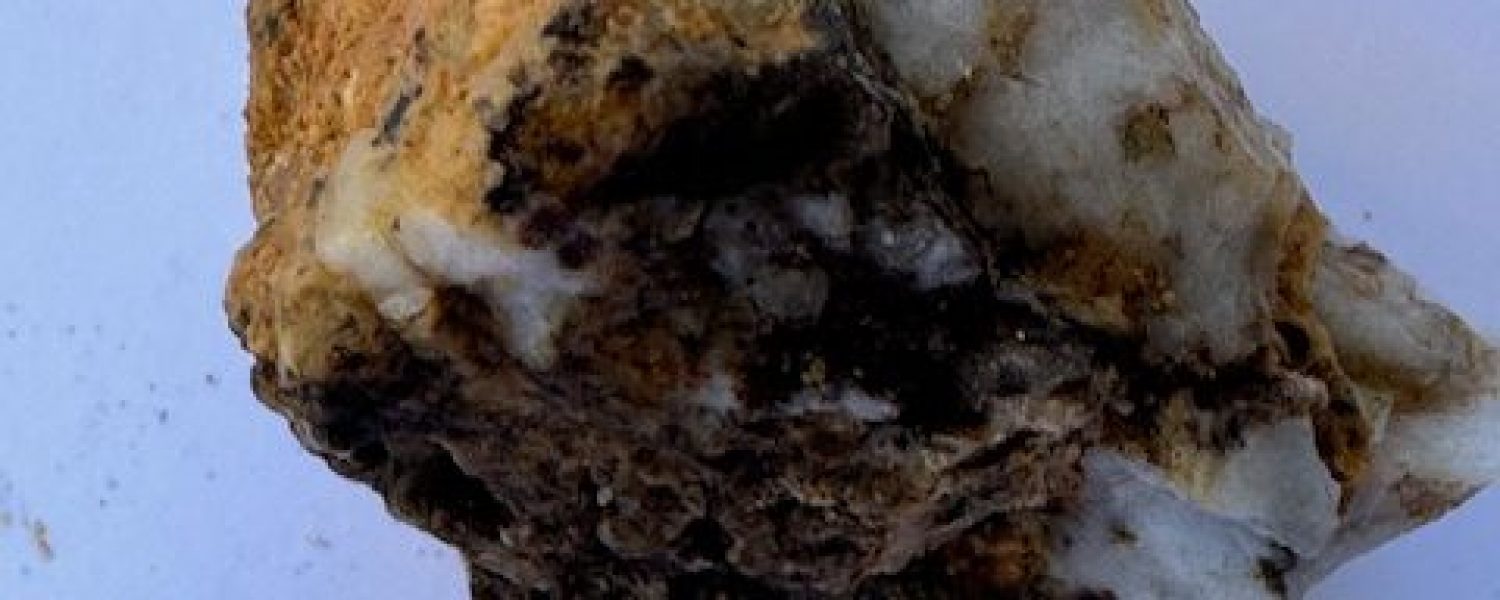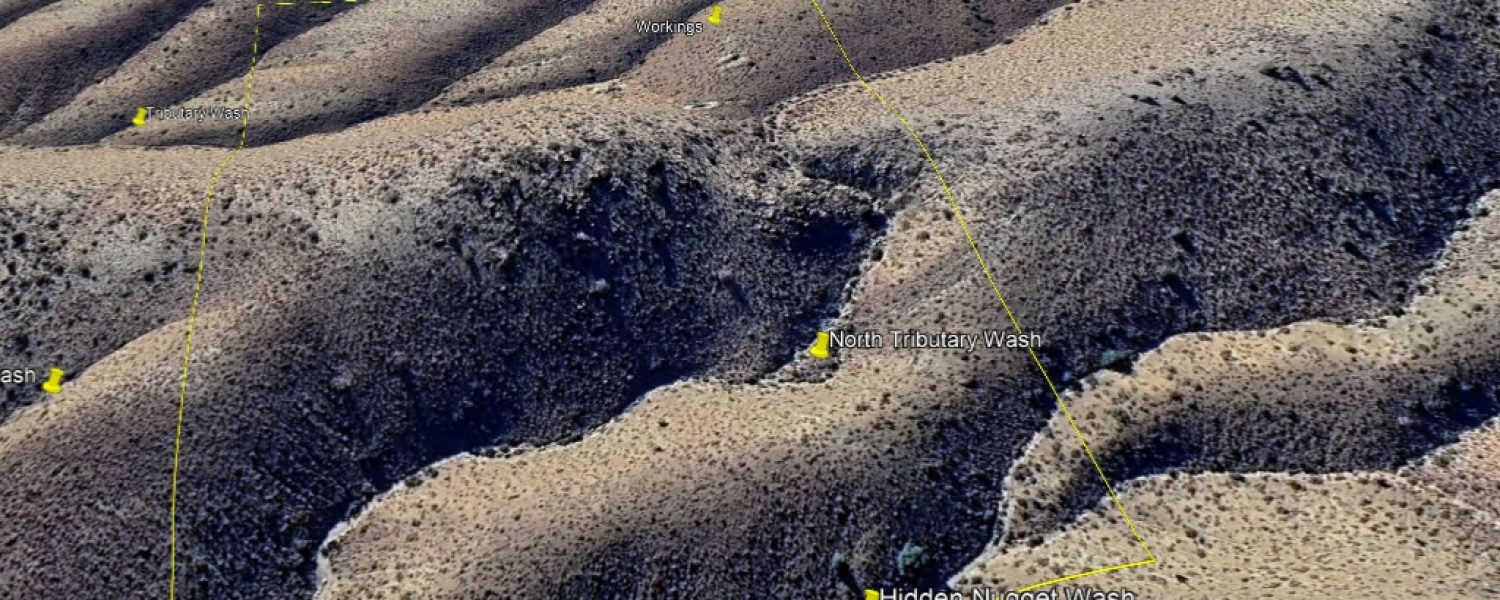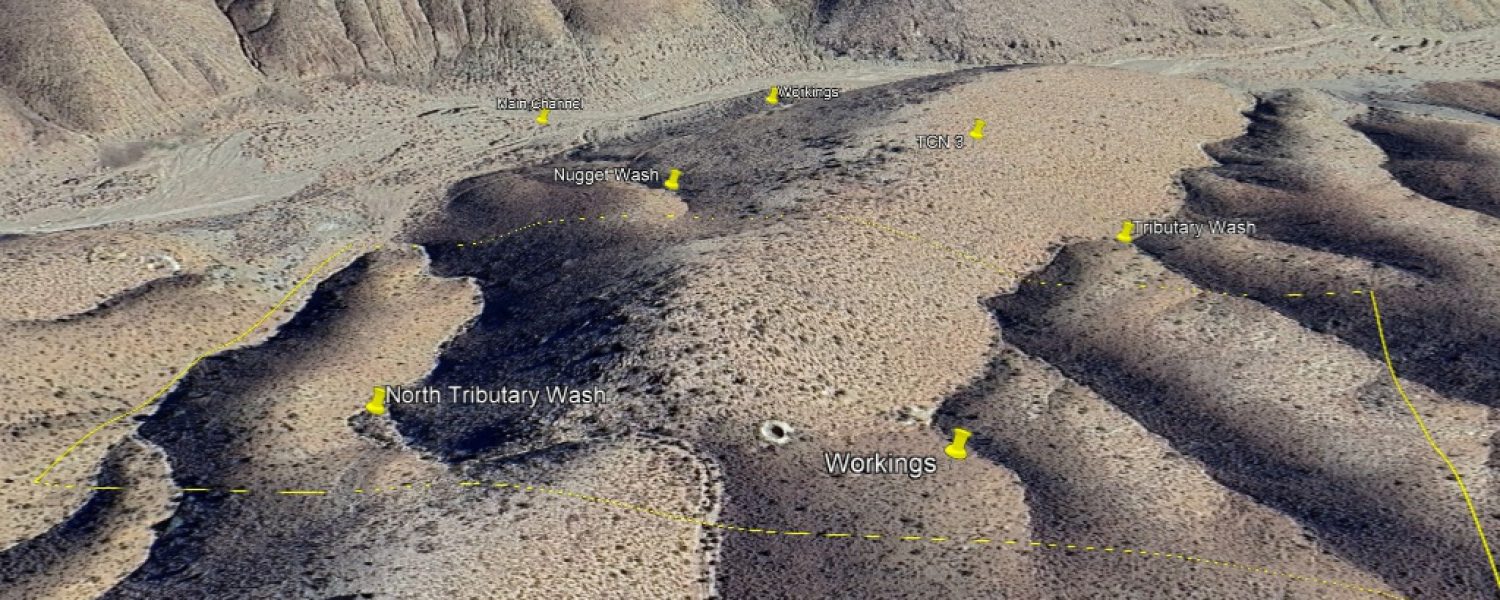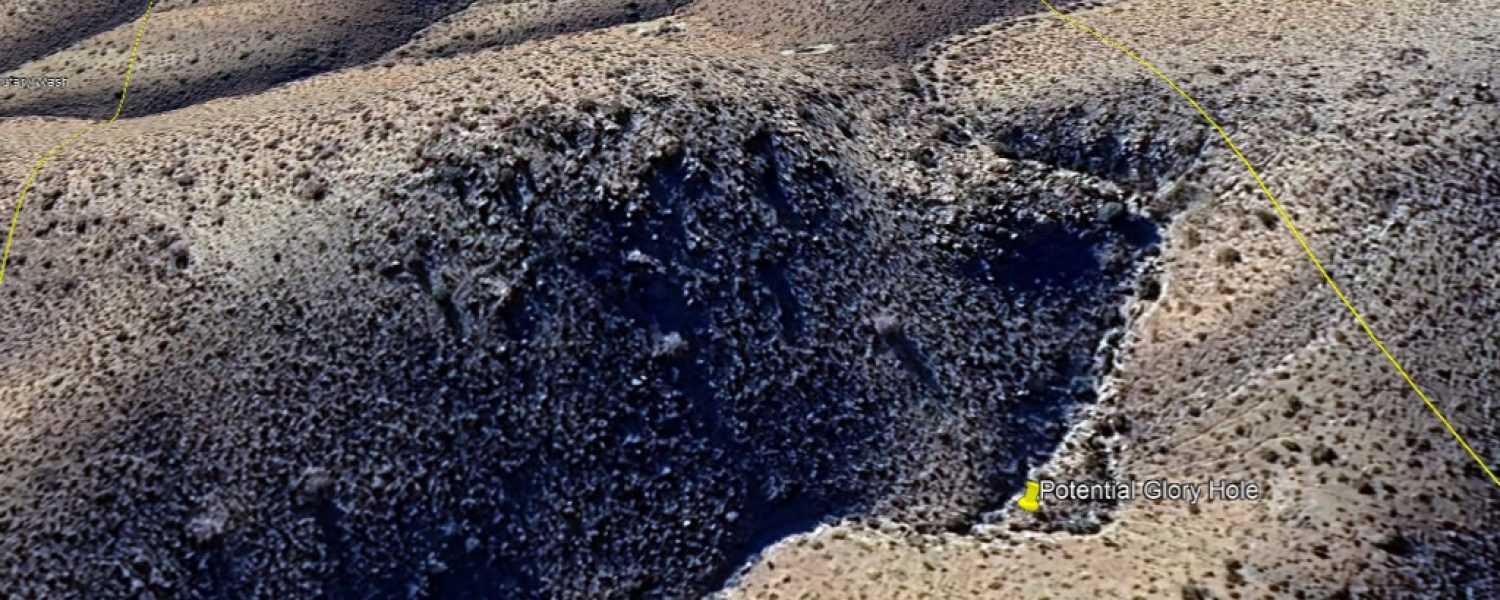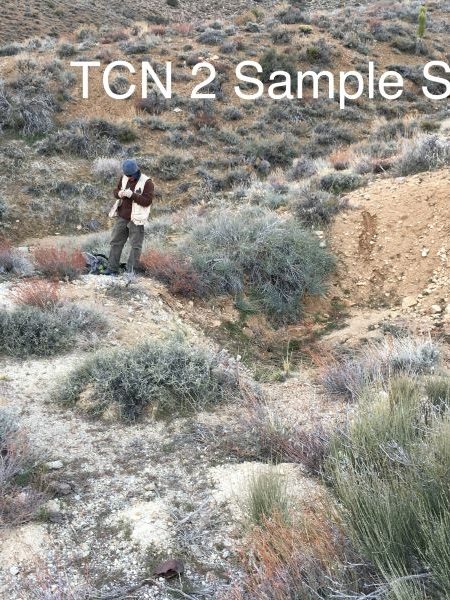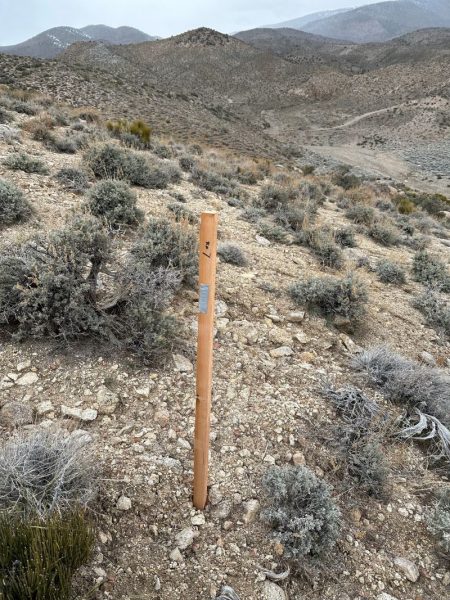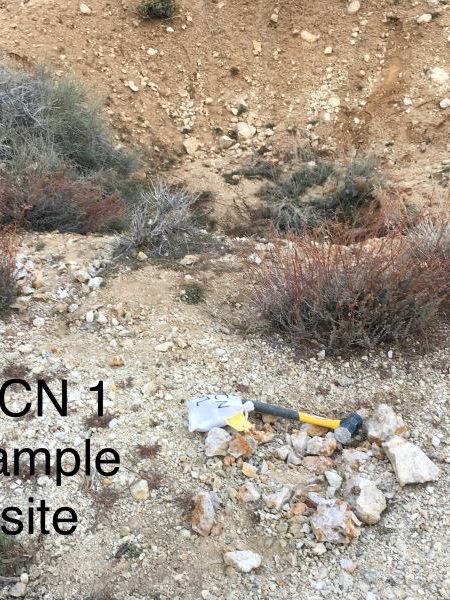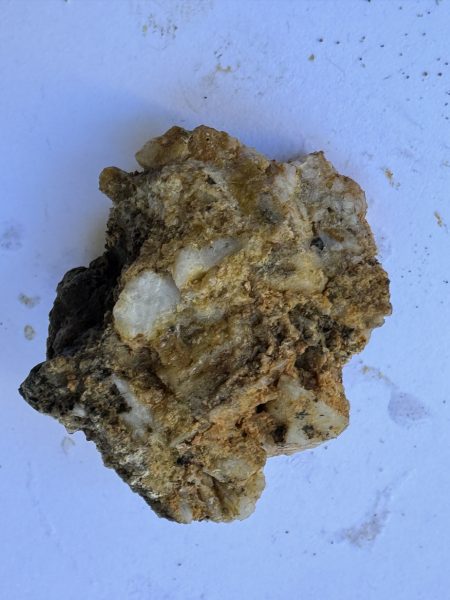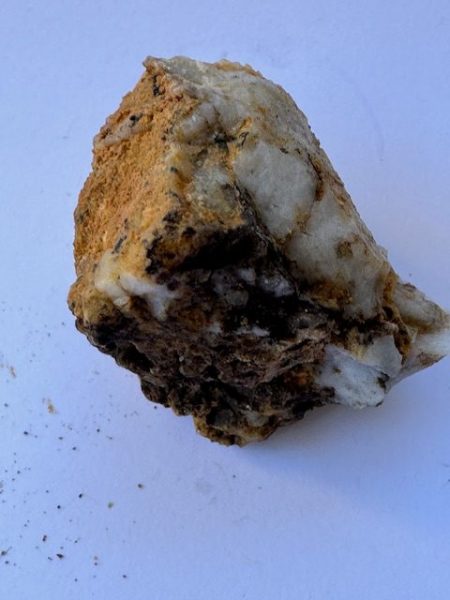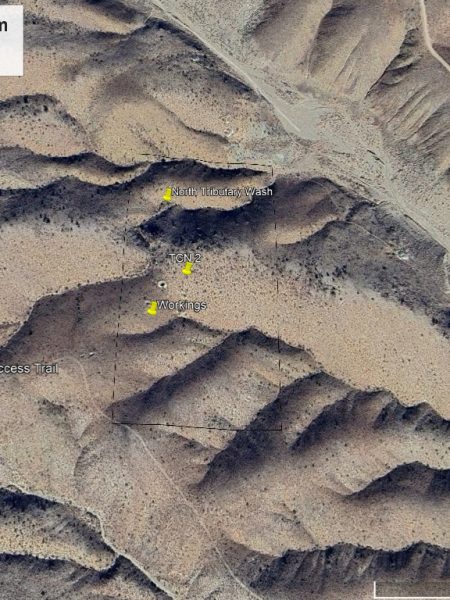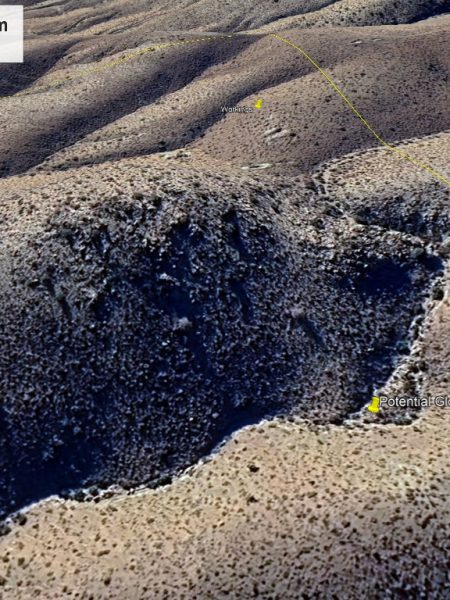TCN 2 PLACER GOLD MINING CLAIM
The TCN 2 claim consists of one (1) unpatented lode mining claim, covering 20 acres, on federal land managed by the U.S. Bureau of Land Management. The claim covers historical placer workings on Tule Canyon.
The TCN 2 claim covers two tributary washes to the west of the main channel as well as several surface hardrock workings, tailings, and ore piles.
Tule Canyon and its tributaries have deep sands and gravels which have not been exhausted by the historical operations. Moreover, there is trenching and other workings on the canyon sides with more gold bearing material.
The average depth to bedrock in the Main Channel is 16 feet. Past operations have averaged 6 feet of pay gravels that averaged $2 per cubic yard in 1933 (0.1 gold ounces per cubic yard) (Vanderburg 1936). Much of the gold is coarse and rough and sometimes attached to quartz – indicating it has not traveled far.
The tributary washes usually have shallower depth to bedrock (5-7 feet) and many of them are unmined.
Recently had a client do some test mining at Tule Canyon (south of this claim) and he confirmed there was gold there. He mined about 20% of the historical grades only halfway to bedrock.
Several hardrock mines dot the edge of Tule Canyon with reported historical grades as high as 4 gold ounces per ton.
Directions: From Las Vegas, Nevada drive north on Highway 95 for 163 miles. Take a left (west) on NV-266 and drive 19 miles to Lida, Nevada. Take another left at Tule Corral Rd. and drive south for 10.8 miles to Tule Canyon.
GPS Coordinates: Lat: 37.361427°, Long: -117.537062° (Waterfall Base Catchment Area)
Mining and Exploration Potential: The existing gravels, tailings and hillside workings offer plenty of scope for initial mining operations. All of these features should be tested to find the highest paying locations.
There are 3 washes on the claim: Hidden Nugget Wash (north), Waterfall Wash (central and longest), and South West Tule Wash (southernmost and biggest tributary of the Main Channel).
All three are promising for placer mining and prospecting. The Waterfall Catchment Area would probably be the best area for a traditional gold trap and should be a priority.
As mentioned above only the upper part of Tule Canyon was mined using modern methods during 3 years in the 1930’s. Pay gravels averaged 6 feet depth above bedrock, 100 foot Canyon width, and 1500 feet length per claim (33,000 cubic yards at 0.1 gold ounces per cubic yard per claim just in main wash). These figures come from W.O. Vanderburg’s 1936 ‘Placer Mining in Nevada’, page 82.
In addition to the traditional placer deposits, TCN 2 has several hardrock deposits, veins, ore piles and tailings on the hillsides.
I have found high grade veins all through the hills surrounding the Canyon – the likely source of the gold.
Despite the difficulties of the time, the 1930’s dragline operation in the northwestern part of the canyon was reported to be successful.
Getting an excavator and other equipment into the Canyon will be no problem. The road from Lida is excellent and well packed (see picture).
This is the type of District that could keep you busy for 20 years. There is definitely lots of gold – both placer and lode.
The Tule Canyon District lies in southern Esmeralda County, Nevada centered around Tule Canyon. Tule Canyon starts in the foothills south of Magruder Mountain and runs east for 5 miles then turns south and runs another 6 miles where it joins Oriental Wash in the northern edge of Death Valley.
W.O. Vanderburg, the author of ‘Placer Mining in Neavda’ estimates that gold was discovered in Tule Canyon in 1876. However, many other sources have mentioned that placer mining was already been conducted in Tule Canyon prior to the 1860’s when the Nevada Territory was first being settled by Americans. Indeed, Mexican miners mentioned that Native American miners were active prior to their arrival.
In 1876, Chinese workers were imported to work the northern part of the canyon (about a mile from the TCN 2 placer claim). Due to the scarcity of water most of the mining was done by hand with small pans. That this method was worthwhile and paid suggests that the gravels were very rich.
The period between 1880 and 1895 was the busiest period and Tule Canyon got a US Post Office at Senner near the part of Tule Canyon where it doglegs south.
It is estimated that $12M in gold was mined during this early period when gold was $20 per ounce. There are records of large nuggets found during this time period – the largest being 52 ounces! The head of Tule Canyon is named ‘Nugget Gulch’.
The Long Sam Mine was active during this period and employed three miners working gold ore worth $75 per ton (3.75 gold ounces per ton) using two arrastras.
During the heyday of the Goldfield and Tonopah mines (1900-1920) several Tule Canyon mines were listed on the local stock exchanges and were co-owned by some of the famous mining operators of the day.
William Ingalls, the well-known and popular Sheriff of Esmeralda County for over 30 years, owned one of the best properties in Tule Canyon, the Ingalls Mine. This mine was worked by lessors for over 20 years and was estimated by one source to have produced over $4M in gold (at $20 per ounce)!
Beginning in 1933, the Los Angeles Rock and Gravel Corporation worked 8 claims at the upper end of Tule Canyon. They used a dragline and shovel, standard grizzly and trommel, and powered the plant with a Ford Model A engine. They piped water from a spring in nearby Weatherspoon Canyon. I think this might be part of the pipes shown in the above pictures. They employed 12 workers.
Active mining in the District ended with Order L-208 closing the gold mines at the beginning of World War II. There have been periodic small operations since then.
A publicly traded junior mining company, Silver Range, owns several claims in the District (centered on the hardrock source of gold).
The Lida District to the north is just to the north and is currently experiencing a small renaissance. Lida was discovered about the same time as Tule Canyon and was known for exceptional rich ore that could run as high as 33 ounces of gold per ton. Currently there is an exploratory drill program just south of Lida (I drove past the drill a few months ago).
Regional Geology: The TCN 2 claim is located in the Walker Lane Mineral Belt within the Basin and Range physiographic province. The Basin and Range province covers most of Nevada and consists of narrow NE trending mountain ranges between flat, arid valleys and basins. The Walker Lane mineral belt is an area with a high density of parallel strike-slip faults extending from Reno to Las Vegas roughly along the California- Nevada border. Faulting and volcanic activity make the Walker Lane favorable for hosting gold and silver deposits including some of the most famous precious metal mining districts in the US including the Comstock, Goldfield, Tonopah, Bullfrog, Mineral Ridge, and Round Mountain. Approximately 75 million ounces of gold is estimated to have been mined in the Walker Lane.
Local Geology: The Tule Canyon District is in a north-trending dog-leg canyon which cuts through Jurassic Sylvania Pluton. The Sylvania Pluton consists of highly weathered and fractured quartz monzonite. The pluton contains massive quartz veins in shear zones and faults.
There are older sedimentary rocks within the pluton that have been partially metamorphosed. The sedimentary-igneous contact is mineralized and contains altered shear zones.
The District has a series of east-west trending high angle faults. Associated with the faults are abundant quartz veins and stringers which can carry pyrite, chalcopyrite, galena, and tetrahedrite. Some iron oxides and supergene copper are present.
The placer gold found in these high-grade stringers was collected and concentrated at the narrow Tule Canyon very effectively. Moreover, the Canyon is studded with additional hardrock resources.
Available Reports:
Albers, J.P. and Stewart, J.H., Geology and Mineral Deposits of Esmeralda County, Nevada, Nevada Bureau of Mines and Geology, 1972.
Murbarger, N., ‘Golden Treasure of Tule Canyon’, Desert Magazine, December 1951.
Patera, A., ‘Palmetto, Sylvania and Tule Canyon, Nevada’, Western Places No. 44, Western Places, 2022.
Tingley, J.V., Tule Canyon District Summary Report, Nevada Bureau of Mines and Geology, 1983.
Vanderburg, W.O., ‘Placer Mining in Nevada’, Bulletin 27, Nevada Bureau of Mines and Geology, 1936.
FAQ
Why Nevada?
Nevada is consistently ranked as one of the top mining jurisdictions in the world for being mining-friendly and continuing to produce major discoveries. If Nevada was a country it would be the 5th largest gold producer in the world (after Australia, Canada, China, and Russia). Nevada is home to the Carlin Trend, the Cortez Trend, the Walker Lane Trend, the Getchell Trend and many other prolific gold producing regions. In addition to gold Nevada also has major mines producing silver, copper, lithium, iron ore, magnesium, gems and many other minerals. Nevada is 85% owned by the federal government and most of this land is available for claim staking. This means some of the best mining ground in the world is open to small prospectors – a very unique situation. There are many mining companies active in Nevada and therefore, multiple potential buyers for any discovery you make. Canadian based junior exploration companies are particularly active in Nevada.
Why Buy a Claim?
Buying a claim is a great way to get started in mining and prospecting. Buying a claim that is professionally staked reduces your upfront work and the risk of making a mistake on your paperwork or in the field. Our claims are in areas with historical mining activity and most have numerous pits, shafts, and adits to explore. Finding these claims takes lots of research that is already done for you. The best place to find gold is where people have already found it!
Why Us?
I have been working in mineral exploration in the southwestern United States and Alaska for 18 years. I have co-founded four junior mining companies and managed numerous drilling and exploration projects. I have worked with large and small mining companies and know what types of projects they are looking for that can be advanced by small prospectors. I have also worked on small hardrock production projects. I usually try to find claims that have known high grade veins that can be produced and that also have some exploration upside. We stand by our claims and fix any problems that come up. We can also help you with your annual filings. We hire the same professional claim staking companies that the large mining companies hire and all the claims have professionally drafted and accurate maps.
How is ownership of the claim transferred?
Ownership of mining claims is transferred with a Quit Claim Deed which we prepare. We pay all claim transfer fees and file the claim transfer paperwork with the BLM and Esmeralda County. The BLM takes about 2-3 weeks to process the claim transfer (Quit Claim) and register the claim in your name. Once the transfer is complete we will send you all the original documents including the file stamped Quit Claim Deed, the original location notices and claim maps.
How Much are the Annual Claim Fees?
The BLM charges a $165 per claim annual maintenance fee which is due on September 1st each year. The BLM fees can be paid online through their claim management portal. Esmeralda County requires that a Notice of Intent to Hold form is filed the first year by Nov 1st along with payment of the recording fee of $12 plus $12 per claim.
If you own less than 10 mining claims you can qualify for a waiver of the annual maintenance fee by filing a Small Miner’s Waiver. However, the Small Miner’s Waiver requires that you perform $100 in labor or improvements on the claim each year.
International Buyers
International buyers must either have dual US citizenship and US address or have a US entity or company to own the claim.
